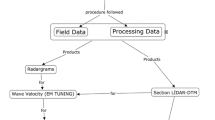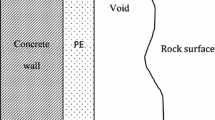Abstract
A geophysical survey routine is proposed to detect underground cavities and dolines; it is based on the sequential application of magnetic, low-frequency ground penetrating radar (GPR) and microgravity techniques. A case study near Zaragoza (Ebro valley, Spain) demonstrates the applicability of these methods. The strong contrast of magnetic and electromagnetic properties (and to a lesser scale, of density) between the doline filling and the surrounding stratified Tertiary and Quaternary rocks allows the shape of filled cavities to be clearly outlined by these methods.





Similar content being viewed by others
References
Alastruey I, Alastruey J, Ayuso N, Cuchí JA, Lera F, Mediano A, Molina P, Villarroel JL, Viñals V (2002) Inducción magnética y técnicas asociadas en el estudio del karst. In: Carrasco F, Durán JJ and Andreo B (eds) Karst and Environment, pp 505–510
Annan AP, Cosway SW, Redman JD, (1991) Water table detection with ground-penetrating radar. In: Soc. Explor. Geophys (Annual International Meeting Program with Abstracts), pp 494–497
Arlegui LE, Simón JL (2001) Geometry and distribution of regional joint sets in a non-homogeneous stress field: case study in the in the Ebro basin (Spain). J Struct Geol 23:297–331
Ballard RF (1983) Cavity detection and delineation research. Report 5, Electromagnetic (radar) techniques applied to cavity detection. Technical Report GL, 83–1, pp 90
Benito G, Casas AM (1987) Small-scale deformations in Quaternary deposits in the northeastern Iberian Peninsula. Géologie Méditerranéenne 14:233–243
Benito G, Gutiérrez F, Pérez-González A, Machado MJ (2000) Geomorphological and sedimentological features in Quaternary fluvial systems affected by solution-induced subsidence (Ebro Basin, NE-Spain). Geomorphology 33:209–224
Benito G, Pérez P, Gutiérrez M, Sancho C (1995) Natural and human-induced sinkholes in gypsum terrain and associated environmental problems in NE Spain. Environ Geol 25:156–164
Beres M, Luetscher M, Olivier R (2001) Integration of ground-penetrating radar and microgravimetric methods to map shallow caves. J Appl Geophys 46:249–262
Bielza V, Martínez-Gil FJ, Carceller T, Garrido E, Nerín C, Sánchez Y, del Valle J (1993) Contaminación del Manto Freático del Corredor del Ebro. Fundación Nueva Empresa. Zaragoza
Bishop I, Styles P, Emsley SJ, Ferguson NS (1997) The detection of cavities using the microgravity technique: case histories from mining and karstic environments. Geol Soc Eng Geol Spec Publ 12:153–166
Butler DK (1984) Microgravimetric and gravity gradient techniques for detection of subsurface cavities. Geophysics 49(7):1084–1096
Buttrick D, Schalkwyk van A (1998) Hazard and risk assessment for sinkhole formation on dolomite land in South Africa. Environ Geol 36:170–178
Colley GC (1963) The detection of caves by gravity measurements. Geophys Prospect XI:1–9
Cook JC (1965) Seismic mapping of underground cavities using reflection amplitudes. Geophysics 30(4):527–538
Cook JC (1974) Yes, we can locate solution cavity boundaries. In: Coogan AH (ed) Rock mechanics and geophysics, 4th symposium on salt, vol 2, pp 33–40
Davis JL, Annan AP (1989) Ground penetrating radar for high resolution mapping of soil and rock stratigraphy. Geophys Prospect 37:531–551
García-Castellanos D, Vergés J, Gaspar-Escribano J, Cloetingh S (2003) Interplay between tectonics, climate, and fluvial transport during the Cenozoic evolution of the Ebro Basin (NE Iberia). J Geophys Res 108:2347–2364
Guerrero J, Gutiérrez F, Lucha P (2004) Paleosubsidence and active subsidence due to evaporite dissolution in the Zaragoza area (Huerva River valley, NE Spain): processes, spatial distribution and protection measures for transport routes. Eng Geol 72:309–329
Gutiérrez F, Arauzo T, Desir G (1994) Deslizamientos en el escarpe en yesos de Alfajarín (Zaragoza). Cuaternario y Geomorfología 8:57–68
Gutiérrez-Elorza M, Gutiérrez-Santolalla F (1998) Geomorphology of the Tertiary gypsum formations in the Ebro Depression (Spain). Geoderma 87:1–29
Gutiérrez-Santolalla F, Gutiérrez-Elorza M, Marín C, Desir G, Maldonado C (2005a) Spatial distribution, morphometry and activity of La Puebla de Alfindén sinkhole field in the Ebro river valley (NE Spain): applied aspects for hazard zonation. Environ Geol 48(3):360–369
Gutiérrez-Santolalla F, Gutiérrez-Elorza M, Marín C, Maldonado C, Younger PL (2005b) Subsidence hazard avoidance based on geomorphological mapping in the Ebro River valley mantled evaporite karst terrain (NE Spain). Environ Geol 48(3):370–383
Hinze WJ (1991) The role of gravity and magnetics methods in engineering and environmental studies. Investig geophys 5:75–126
Knez M, Slabe T, Šebela S (2005) Smoganica—a cave developed in upper Cretaceous breccia. Acta Carsologica 34(2):425–438
Knight RJ, Nur A (1987) The dielectric constant of sandstones, 60 Khz to 4 Mhz. Geophysics 52:644–654
Mathé V, Lévêque F, Mathé PE, Chevallier C, Pons Y (2006) Soil anomaly mapping using a caesium magnetometer: Limits in the low magnetic amplitude case. J Appl Geophys 58:202–217
Matthews MC, Clayton CRI, Rigby-Jones J (2000) Locating dissolution features in the Chalk. Quart J Eng Geol 33(2):125–140
McGrath R.J, Styles P, Thomas E, Neale S (2002) Integrated high-resolution geophysical investigations as potential tools for water resource investigations in karst terrain. Environ Geol 42:552–557
Mochales T (2006) Prospección magnética aplicada a la detección y caracterizción de dolinas en el entorno de Zaragoza. Unpublished MSc University of Zaragoza, 191 pp
Mochales T, Pueyo EL, Casas AM, Soriano MA (2006) Magnetic prospection as an efficient tool for doline detection. A case study in the central Ebro Basin (Northern Spain). In: Parise M, Geological Society of London. Special Publications: natural and anthropogenic hazards in karst: recognition, analysis and mitigation (unpub. data)
Neal A, Pontee NI, Pye K, Richards J (2002) Internal structure of mixed-sand-and-gravel beach deposits revealed using ground-pentrating radar. Sedimentology 49:789–804
Pardo G, Arenas C, González A, Luzón A, Muñoz A, Pérez A, Pérez-Rivarés FJ, Vázquez-Urbez M, Villena J (2004) La Cuenca del Ebro. Geología de España, IGME
Pedley RC, Busby JP, Dabek ZK (1993) GRAVMAG User Manual – Interactive 2.5D gravity and magnetic modeling. British Geological Survey, Technical Report WK/93/26/R
Pérez-Rivarés FJ, Garcés M, Arenas C, Pardo G (2002) Magnetocronología de la sucesión miocena de la Sierra de Alcubierre (sector central de la Cuenca del Ebro). Revista de la Sociedad Geológica Española 15(3–4):217–231
Reynolds JM (1997) An Introduction to Applied and Environmental Geophysics. Wiley, Chichester
Riba O, Reguant S, Villena J (1983) Ensayo de síntesis estratigráfica y evolutiva de la cuenca terciaria del Ebro. Libro Jubilar J.M. Ríos: geología de España, IGME
Rybakov M, Goldshmidt V, Fleischer L, Rotstein Y (2001) Cave detection and 4-D monitoring: a microgravity case history near the Dead Sea. The Leading Edge (Society of Exploration Geophysicists) 20(8):896–900
Rybakov M, Rotstein Y, Shirman B, Al-Zoubi A (2005) Cave detection near the Dead Sea—a micromagnetic feasibility study. The Leading Edge (Society of Exploration Geophysicists) 24(6):585–590
Simón JL, Soriano MA (1986) Diapiric deformations in the Quaternary deposits of the central Ebro Basin. Spain Geol Mag 123:45–57
Soriano MA (1990) Geomorfología del sector centro-meridional de la Depresión del Ebro. Diputación Provincial de Zaragoza
Soriano MA, Simón JL (1995) Alluvial dolines in the central Ebro Basin, Spain: a spatial and developmental hazard analysis. Geomorphology 11:295–309
Soriano MA, Simón JL (2002) Subsidence rates and urban damages in alluvial dolines of the central Ebro Basin (NE Spain). Environ Geol 42(5):476–484
Soriano MA, Simón JL, Arlegui LE, Liesa CL, Pocoví A (2004) Problemas causados por el karst aluvial en el centro de la cuenca del Ebro (España). Stato Dell’arte sullo studio dei fenomeni di sinkholes e ruolo delle amministrazioni statali e locali nel governo del territorio, pp 521–532
Thierry P, Debeblia N, Bitri A (2005) Geophysical and geological characterization of karst hazards in urban environments: application to Orléans (France). Bull Eng Geol Environ 64:139–150
Zhou W, Beck BF, Adams AL (2002) Effective electrode array in mapping karst hazards in electrical resistivity tomography. Environ Geol 42:922–928
Acknowledgements
The authors are very grateful to J. Busby, P. Williamson, A.H. Cooper and F. Gutiérrez for their careful revision of the manuscript; J.J. Curto from the “Observatori magnètic de l’Ebre” for providing diurnal variation data and J.J. Villalaín from the Paleomagnetic Laboratory (Burgos University) for the remanence measurements. This work was supported by projects from the Spanish Ministry of Sciences and Technology (PROFIT: FIT-310200-2004-181). E.L.P. was supported by a “Ramon y Cajal” research position (MEC). Research granted by equipment projects funded by the Universidad of Zaragoza, project DGES BTE2002-04168-C03-01, Spanish Ministry of Education, Aragón Government support to Geotransfer research group, funds from the Instituto Geológico y Minero de España and Elf-exploration-production, and project PM045 from the Aragón Government.
Author information
Authors and Affiliations
Corresponding author
Rights and permissions
About this article
Cite this article
Mochales, T., Casas, A.M., Pueyo, E.L. et al. Detection of underground cavities by combining gravity, magnetic and ground penetrating radar surveys: a case study from the Zaragoza area, NE Spain. Environ Geol 53, 1067–1077 (2008). https://doi.org/10.1007/s00254-007-0733-7
Received:
Accepted:
Published:
Issue Date:
DOI: https://doi.org/10.1007/s00254-007-0733-7




